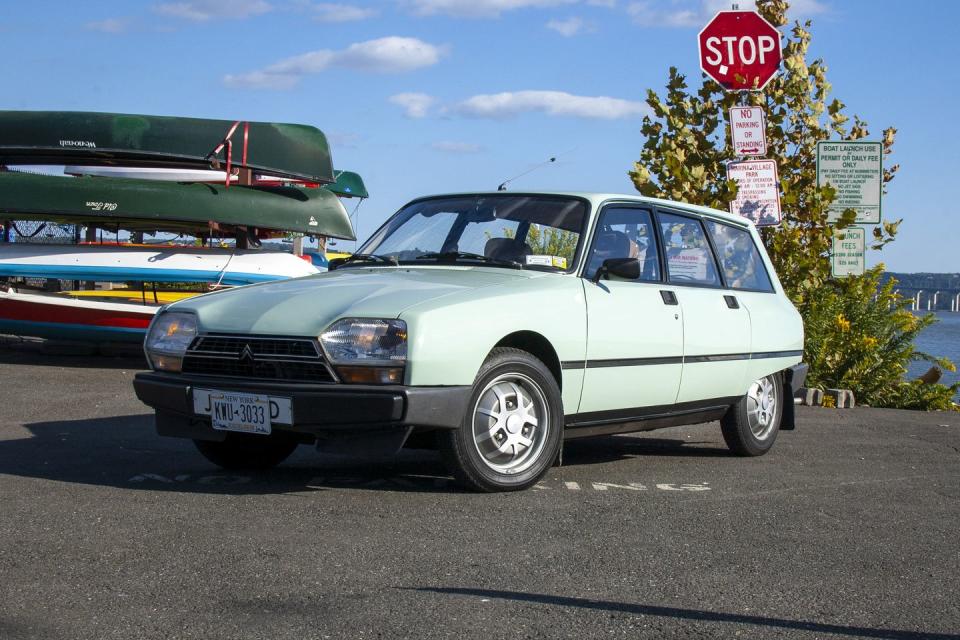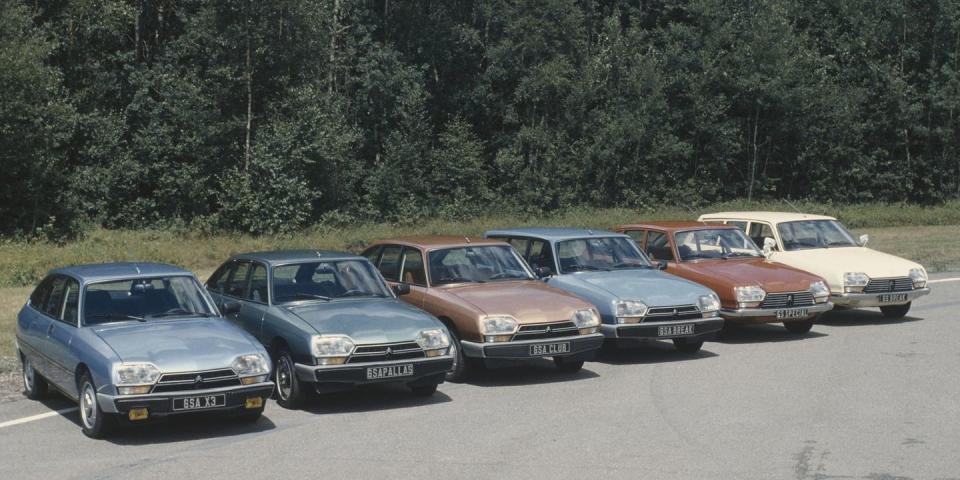In a Just World, Everyone Would Drive a Citroën GS

How much do you need? We buy pickup trucks because we may use the bed once or twice a year; we buy big SUVs to take the kids to school; we buy cars that can hit 60 in under two seconds and pull 2g in cornering….just because. And so on. I don't mean to cast aspersions here because I am as guilty of this in my own way. Yet I am also fascinated by this idea of "enough" car.
I think it goes hand in hand with intelligent cars, cars designed with real thought and care to address societal needs as much as consumer desires. Last year, I drove a perfect example, a 1982 Citroën GSA Break belonging to R&T contributor Jamie Kitman. A car I bet you've never heard of. The GS has been largely forgotten about, despite being an award-winning, critically acclaimed technological tour-de-force in its day. It's still extraordinary. A mass-market family car whose mechanical specification was far more impressive than any rival from the early Seventies. A car that is odd beyond measure, but one that also makes startling sense.

Before the GS, Citroën offered two models, with a handful of variants and derivatives of each, the 2CV and the DS. There was a huge gap between the basic people's car and the complex luxury sedan, one that was to be filled by the GS.
Influence from the DS is obvious. Remarkable for something intended for the mass market, the GS featured Citroën's innovative hydropneumatic self-leveling suspension, and it's the heart of the car. It would take thousands and thousands of words to explain the system in full, so we're just going to deal with the high-level points here.
Attached to each wheel via a swing arm is a small green unit consisting of a very short strut and a sphere at the top. The strut and part of the sphere is filled with a special mineral-based oil, while the top of the unit is filled with pressurized nitrogen, separated by a rubber diaphragm. It operates on a very basic scientific principle—you can compress a gas, but not a liquid. As the wheel moves up and down a piston attached to the swing arm pushes fluid up against the diaphragm, compressing the gas. This effectively does the job of a traditional metal spring. Damping is done by a small valve within the sphere, which limits the flow of the hydraulic fluid. Very simple! Now comes the complicated part.

The whole circuit is pressurized by a belt-driven accumulator that regulates the pressure of the fluid throughout the circuit. Ride height control is provided by a lever attached to the anti-roll bar. As the lever moves up and down from its normal position the hydraulic system adjusts pressure to compensate for the load. Ride height can also be set manually via a lever in the center console. In fact, this is how you jack a hydropneumatic car up, raising the suspension to its maximum height, attaching a jack stand, then lowering it back down, raising up the side of the car. You can even drive on three wheels. If this sounds amazing, consider that Citroën first used this on the rear of the Traction Avant in 1952, and on all four wheels of the DS in 1954.
If none of that makes sense to you, just know that the system provides ride quality unheard of for cars at the time, and great even by today's standards. It was so good, the system was licensed by both Mercedes-Benz and Rolls-Royce. With the GS, you could have it in a mid-level family sedan.

The GS borrowed the idea of using an air-cooled boxer engine from the 2CV, though here, it had four cylinders rather than two. This engine may seem primitive, and to a great extent, it is, but the packaging was also excellent. With no radiators, it was easy to place right at the front of the car, ahead of the transmission, and with fewer parts than a water-cooled engine, Citroën figured it would be more reliable, too. Early examples of the GS made just 55 hp from a 1.1-liter boxer, while this later GSA—the "A" was added during a facelift for 1979—Club Break has 65 hp from a 1.3-liter.
Of course it's slow, but not obtusely so even on American roads. It's a little hard to find an exact weight figure for this car, but it's not much more than 2000 pounds. Citroën was also obsessed with aerodynamics, and its lead designer Robert Opron clothed the GS in bodywork that produced a remarkably low-for-its-time 0.32 drag coefficient. Presumably, this wagon version has a slightly higher figure, but its bodywork, tapering to a Kamm-tail rear, is still slippery. It might take a bit to get up to speed with just 65 hp, but once you're there, the car feels like it glides through the air, almost as if 60-80 happens as quickly as 0-20. Fuel economy is also excellent. Kitman says he regularly sees 37 mpg, though some credit must go to the fifth ratio of the GSA.
Driving the GSA presents its many quirks, in typical Citroën fashion. The steering wheel has a single spoke, which was thought to be safer for drivers in the days before collapsible steering columns. This means there's no hub, and thus no stalks, so all your controls are on pods surrounding the (also wacky) gauge cluster. This also means that the turn signals don't self-cancel, and this will catch you out. There's no tachometer, and the speedometer is a bathroom-scale-style slider. Being a European car, it obviously reads in kilometers, but there are numbers on the bottom of the scale that certainly don't correspond to mph—this is actually estimated braking distance, in meters, naturally. Very safety minded.
For all of the GS's advanced technology, the engine is still carbureted, and there's a choke to aid with cold starts. A bizarre incongruity. When you start the engine, the car slowly rises up on its suspension, as the system pressurizes and the fluid produces a downward force on the tires. Turn it off, and the suspension depressurizes, the car sinking back down to the ground. But all this weirdness is nothing compared to the brakes.
If you already have a hydraulic circuit for the suspension, why not use it for the brakes? That's what Citroën did in all of its hydropneumatic cars, and in many, it used a small rubber button in place of a brake pedal. The button is pressure sensitive, and the amount of force you put into it translates to how much the brakes are squeezed. In the GS, a traditional brake pedal is used…only it operates in basically the same way as the button, with almost no pedal travel. At first, it feels like an on-off switch and after a couple hours behind the wheel, it still sort of feels like an on-off switch, just one you're slightly better at using. (Also worth noting: The GS had inboard front brakes. Of course it did.)
Idiosyncrasies aside, the GS is an incredible cruiser. The seats are soft and come with the headrest cushions that only come on large luxury sedans these days. Then there's the way it goes down the road. Citroën evangelists may lead you to believe that driving a hydropneumatic car is like riding on a magic carpet, though the reality isn't quite like that, it's still wonderful in context. Body rigidity has come a long way in the last 50 years, and so some smaller road imperfections will shake the structure of the car, but the suspension does a wonderful job of keeping the body level. You're aware of road imperfections, though you don't get as much vertical motion as you're expecting. Of course, it rolls quite a bit in corners, though again, this is well managed. Still, 145-width Michelins only provide so much grip, so you're never going to flog a GSA. People also responded to it in a way I wasn't expecting. It's just so different from everything else on the road.
Sadly, the GS was one of the cars that precipitated Citroën's downfall. In addition to the boxer, the GS was offered with a twin-rotor engine, developed at great expense to the automaker. The GS Birotor arrived, it was unreliable and thirsty…which was especially bad considering it launched in 1973. It was scrapped after only a few hundred units were sold, and Citroën never sold a rotary car again. At the same time the GS was launched, the company brought out a flagship grand tourer, the stunning SM. To acquire a more powerful engine for the SM, Citroën purchased Maserati in 1968, which proved to be yet another financially ruinous mistake.
All the while, Citroën was forced to stop selling cars in the U.S. in 1974 because of legislation around headlight heights effectively banning cars with height-adjustable suspension. Take all this and add in the fact that Citroën was also developing the CX, set to replace the DS, and it's no surprise the company found itself in dire straits. The French government forced a merger with Peugeot in 1975, and while Citroën continued to make quirky cars for a few more decades, only abandoning hydropneumatic suspension in 2015, the weirdness was gradually engineered away. For many, the CX was the last true Citroën.

I'm not going to be so obtuse as to suggest that everyone go out and import an old Citroën as daily transportation, but I will say I wish more cars were built in its image. Daily transportation should be economical, efficient, and clever. Good aerodynamics and lightweight construction mean the GS and GSA do a lot with very little, and that brilliant suspension makes every journey a breeze.
Yet, we just want more. Consumers never flocked to Chevrolet's clever Bolt, but you know they're going to buy the new Blazer EV in huge numbers, even if the little electric hatchback is more than enough. If there were any justice in this world, we'd all drive cars a little more like this remarkable Citroën. It is all the car so many of us ever need.
You Might Also Like

 Yahoo Movies
Yahoo Movies 
